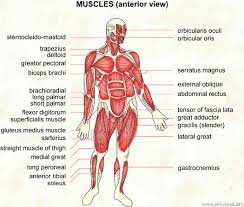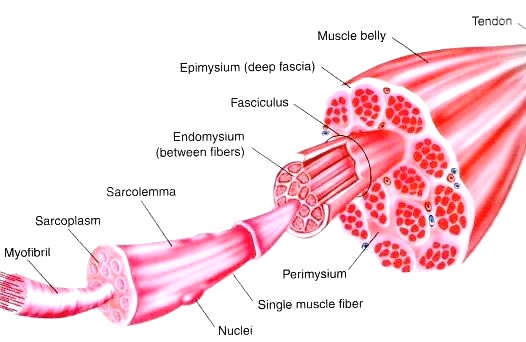They help us move, digest our food, and keep us alive. Here’s a post in celebration of those hunks of meat between our bones.
When you think of muscles, you probably think of something like these:
But when I think of muscles, I think of things like this:
The illustration above is a fairly detailed look at the way a muscle contracts.
A bit of background about myself: I received an M.S. in Health and Exercise Science and a B.S. in Athletic Training. I know how muscles are supposed to work down to the super minute detail. Needless to say, I stared at a lot of diagrams like this one except with more letters and some numbers.
Anyway, like pretty much everything in the human body, muscles are complicated. But the basic mechanism is the same in humans and other animals: muscles move our body, move food through our digestive track, and keep out heart beating.
So we get the main gist of what muscles do. Let’s take a look at exactly how muscles work.
The Basics
So, do you see that diagram above?
The little protrusions that look like the heads of sperm (Note: I apologize for that comparison, but that’s pretty much what I’ve always thought they look like. I could say golf clubs, but that’s not as fun) are the “heads” of a protein called myosin. The band of material that looks like a twisted chain of beads is a protein called actin. The myosin heads will basically grab onto the actin and pull it, which results in a muscle contraction. Get enough of these strands together, and you get a functional muscle unit, which is called a sarcomere. Get a bunch of sarcomeres together and you get a myofibril…as you can see below, these eventually form a muscle.
For a more detailed look at how a muscle contraction works, take a look at this video.
So now we know the basics of how muscles work. Now let’s talk about the different types of muscles in our bodies.
Different Types of Muscles
There are 3 main types of muscle in the human body.
Cardiac
As the name implies, this type of muscle is found in the heart. The heart is an amazing organ. The heart is one giant muscle, and is capable of beating without any type of stimulation from the nervous system whatsoever. Cardiac muscle doesn’t get “tired” like your skeletal muscles do. This is why your heart can keep beating and beating and beating.
Smooth
This type of muscle is found in “hollow” organs, or organs with an opening in the middle, like your bladder and digestive tract organs like your esophagus, stomach, small intestine, and large intestine. When you take a bite of food and swallow, the smooth muscle in your esophagus contracts and helps to push the food down to your stomach. While in your stomach, smooth muscles work to contract, elongate, and churn your food.
Skeletal
Skeletal muscles help us move from point A to point B and are connected to our bones via tendons. We have approximately 75 skmallion different named muscles in our bodies* with different types of skeletal muscles.
*Not scientifically proven and is actually closer to between 600-800
A lot of people, especially athletes, are familiar with hearing the terms “slow-twitch” and “fast-twitch” muscle fibers. Slow-twitch muscle fibers are associated with endurance. Fast-twitch muscle fibers are associated with strength and activities like sprinting and quick bouts of exercise.
Every person has a mix of slow and fast-twitch muscle fibers. For example, our eyelids contain a lot of fast-twitch muscles since our eyelids are needed for very fast motion, not for eyelid-blinking endurance. Our calf muscles mostly consist of the gastrocnemius and the soleus muscles, with the gastrocnemieus muscle the more exterior muscle. The soleus muscle is especially built, in most people, for endurance, so it will contain more slow-twitch muscles.
Does Knowing If You Have Type 1/2 Matter?
If we’re talking about athletic performance, it could definitely matter. Most people have a genetic predisposition for muscle types. Some people are lean and will not be able to pack on a lot of muscle mass. Some people can gain muscle mass very easily. Some people have more fast twitch or slow twitch muscle fibers than normal. If someone knew they had an abundance of slow twitch muscle fibers as opposed to fast twitch, that person could benefit by training to be a long distance runner as opposed to a sprinter.
This type of DNA testing is now available. I had my genome tested and the company told me that I was a likely sprinter. Am I a sprinter? No. But it’s not telling me that I would be a world-class sprinter. It’s just telling me that I would likely be better at sprinting than an endurance athlete. Had I known this information when I was younger, maybe I could have tailored my exercise/sports training to my genes.
This brings up an ethical dilemma for some people. This is still a relatively new field of study, and some people find that tailoring things to what your genes say takes away a person’s free will. We may save this for another blog post (oooooh, good idea!), but as far as telling me what types of muscle fibers I have, I find this highly interesting and wish I had known sooner.
Needless to say, this isn’t going to keep me from running long distances. But it WILL make me feel just a smidge better that I’m not very fast at it. I’ll just blame it on my genes.
When Muscles Break Bad
Oh humans…we are a silly lot. We do silly things like jumping off high places and playing sports where we launch our bodies at each other. While these things are highly entertaining, they lead to things breaking and tearing, and this includes muscles. I do love looking at gruesome sports injuries, and I’ll spare you posting any of those here, but let’s take a look at the different ways muscles can betray us.
Muscle strains, pulls, and tears
A strain usually occurs when a muscle is stretched too far and tears. Strains, pulls, and tears can sometimes refer to the same injury and can be used interchangeably. Depending on the severity, these can be very painful and usually are treated with rest, ice, and anti-inflammatories, such as ibuprofen.
Muscle soreness
What causes muscle soreness? Scientists have been studying muscles for years, and this is one of those questions that is still being investigated today. Is it a buildup of lactic acid, which is a by-product of using our muscles? Is it caused by tiny, microscopic tears in our muscles?
The thought that lactic acid causes muscle soreness is something that has not held up to scientific research. Lactic acid does build up in the body while exercising, but the body gets rid of lactic acid in about an hour. The research so far tends to indicate that soreness after exercise tends to happen due to tiny, microscopic tears in muscles.
So if tiny tears cause soreness and pain, isn’t that your body’s way of telling you to STOP IT? How does this lead to stronger muscles? Your body responds to these tears by repairing and rebuilding the muscle stronger than it was–repeat this process enough, and you’ll end up with bigger and stronger muscles.
Thanks for reading this edition of “How Stuff Works”. Do you have any questions about muscles? Be sure to leave it in the comments.




